- 1863 Richmond Short Rifle
- 1863 Richmond Short Rifle, Stock
- 1863 Richmind Short Rifle, Forward Stock
- 1863 Richmond Short Rifle, Lock Plate
- 1863 Richmond Short Rifle, Cocked Hammer
- Richmond Short Rifle, Rear Barrel Band
- Richmond Short Rifle, Forward Barrel Band
- 1863 Richmond Short Rifle, Front Sight
- Richmond Short Rifle, Rear Sight
- Richmond Short Rifle, Split Stock
- Richmond Short Rifle, Proofs
- 1863 Richmond Short Rifle Rear Sight
- 1863 Richmond Short Rifle Exposed Rear Sight
- 1863 Richmond Short Rifle Expose Lock Plate View
The job of harvesting trees to make gun stocks, limber carriages and wagons was hard. These jobs were done by experienced lumber jacks, most of which had learned from their fathers. Unfortunately for the South most of these men were fighting the Yankees in one way or the other. I
When Captian Turner Ashby and Company raided the arsenal in Harpers Ferry in April of 1861 he managed to confiscate 1000’s of rifle stocks, most were 1st quality stocks that the Richmond Armory used to assemble rifles, however many were 2nd quality stocks that had defects of some sort and wouldn’t pass the quality inspection that qualified them to be issued.
Fast forward to 1863 when all the confiscated 1st quality rifle stocks had been used and the Richmond Armory could not get any black walnut wood from their suppliers, mostly in and around the Macon Georgia area. This created a big problem for the Confederacy, with no quality wood to make rifle stocks how would they continue to fight a war?
As mentioned earlier, Stonewall Jackson’s raid on the Arsenal in Harpers Ferry he confiscated 1000’s of rifle stocks which were used to make Richmond rifle muskets. But the 2nd quality stocks were not used due to their defects. Now the South was in a real jam, they were in desperate need of arms but they had no black walnut to make them with.
So they turned their attention to the 2nd quality stocks that were not perfect but better than nothing. Many of these stocks were splintered and cracked. Southern cavalry troops were in desperate need of carbines and short rifles. By this time the Northern cavalry was armed with breech loading carbines that could be loaded quickly and shoot accurately some were issued Spencer carbines that could hold up to 7 brass cartridges which made them great assets for Cavalrymen.
The Richmond Armory with their master mechanics were forced to make rifles from damaged and broken stocks. Many of these weapons will be assembled using hardware from Union weapons that were found on battlefields.
That brings us to the next example in the Civil War Arsenal. This 1863 Richmond Virginia Short Rifle is made from a mix of old Union parts and Southern parts. Categorized in Paul J. Davies book, “C.S. Armory Richmond” as a Richmond Short Rifle (Old Parts) a total of 461 were made. In June of 1864, 261 short rifles were pieced together and in July of 1864, 200 short rifles were made. There were another 850 of these Short Rifles made categorized in Mr. Davies book as (New Parts) made with 1864 lock plates and brass/copper butt plates.
This Short Rifle has a split stock under the barrel band closest to the breech plug held together with an iron U shaped staple. Removing the lock plate shows the elimination of the primer feed for the Maynard Primer System this proves that this section of the stock is Southern made, or as I like to say “Southern Wood”. However the forward portion of the stock, beyond the stapled barrel band is from a Union Rifle with an iron stock tip and iron screw. The butt plate is iron without the U.S. stamp and the barrel bands do not have the usual U on them. The barrel measures 33” long with a pinched front sight and has the VP and eagle on the left side by the breech plug.
All in all this is a fine example of the resourcefulness of the South and a great piece of American history; I hope you enjoy the photos.
I buy Richmond carbines, short rifles, and rifled muskets as well as any and all parts regardless of condition. If you have any Richmond weapons or parts for sale please contact me at civilwararsenal@yahoo.com thanks for stopping by, Gene West


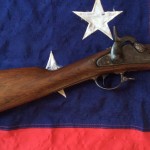
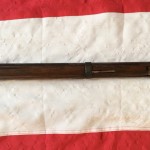
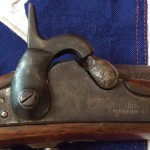
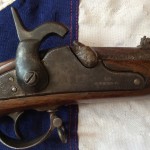
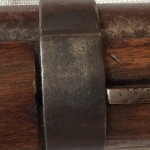
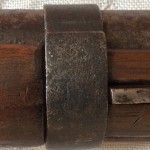
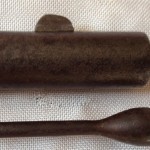
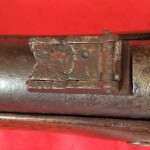
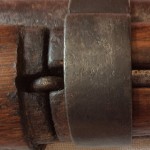
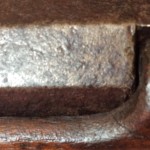
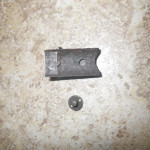
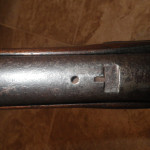
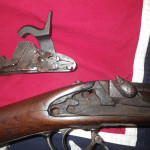
Hello Eugene,
First of all I would like to say how much I enjoyed looking at your website, it really got me thinking.
I have attached a sheet showing a Richmond carbine/musketoon that I have in my collection. The stock lock, barrel bands, trigger guard, butt plate are all Richmond. Not sure about the nose cap, and the swelled ramrod is 1855 pattern with a threaded end. The stock is of the two piece variety with the forearm joined under the lower barrel band.
The barrel is clearly cut down to 30.5 inches and is too large to take a bayonet. The bore is .610 smoothbore. It has numerous minute flaws associated with Richmond barrels but the sight, although found on Confederate arms, I do not think was made there. Also, there is no tee slot cut for it in the top of the barrel. This puzzles me.
Do you think the barrel and sight could be Richmond products?
Love your gun racks, what an excellent way to display without using up too much space.
Good luck,
J
Hello Gene,
Thank you for such a fast reply. I am about to go out for the evening but I will do as you say. Already I can answer some of your questions but will photograph as well.
The front sight I think is wrong but very well made! The mules foot is present, no cartouches seen but I will look again In good light, the butt plate is brass and unmarked, no star but the P has a slight nick on the top part of the curve, other details I will have to check.
I know that there are many made up Richmond muskets around.
Good luck,
J
Do you think the barrel and sight could be Richmond products?
Love your gun racks, what an excellent way to display without using up too much space.
Good luck,
J
J,
Thanks for the kind words about web site and gun racks, the gun racks were made by a local carpenter and they work great for the application.
The rear sight on the weapon you have is not Southern it is Northern made and if the barrel doesn’t have a cut for the rear sight steady pin it’s an indication that it’s northern made. But the Richmond Armory retooled thousands of Northern weapons that were picked up on the battlefield. Southern foot soldiers would scavenge the battlefields looking discarded weapons in good, bad and indifferent condition. These would then be sent to the Armories to be rebuild and reissued to the troops.
I would love to see more photos of the weapon you have. If you could provide me photos of the.
1. Front sight must be a pinched sight, not the conventional sight found on Springfield’s and Enfield’s
2. Remove rear sight and photo the area on the barrel
3. Remove the lock plate and photo the cavity in the stock, this will determine if the stock is of Southern origins.
4. The left side of the stock opposite the lock plate, for cartouches
5. The butt plate, is it brass of steel, does it have U.S. on the tang
6. Remove the barrel and photo the nose cap from inside the barrel cradle as well as from the bottom of the stock. Is it brass or steel, is there a screw or rivet holding it in place? The South didn’t have the ability to rivet the nose cap, they only used screws.
7. Closeup photos of the U on the barrel bands, while there positioned on the weapon. The U must be facing the right side of the rifle. Southern barrel bands had U’s that were off center or not in line with the spring fastener.. Northern mechanics had machines to stamp the U, Southern Mechanics used a hand stamp due to the lack of resources and the U is never in the same position
8. Is there a star on the left side of the barrel forward of the VP and eagle?
So if you can provide me with photos and information that I’m requesting I should be able to help you further. Richmond Weapons come in many different sizes and shapes and many unscrupulous dealers have doctored Union pieces to increase the values. You need to be well studied in the art of Richmond’s/Southern weapons to identify weather the weapon is authentic.
Look forward to hearing back from you, Gene
Yes cartouches did appear on some Richmond’s that were made early in the war, the intials SA (Salmon Adams) in a square box was the inspector for the Richmond Armory. However there were many Richmond’s made from stocks that were confiscated from the Harpers Ferry Armory at the outbreak of the war. These Stocks were then shipped to Richmond Virginia and fitted for Richmond rifle muskets, carbines and short rifles throughout the war.
It’s the main reason why Richmond weapons are hard to identify because so many were made with Union parts and many people have put lock plates on union weapons to increase there values, but we talked about that earlier. It’s one of the reasons I spend the time documenting there history to help prevent such a thing. I’ve been burned before. It’s not fun.
J,
Enjoy your Southern weapon it is a piece of American history and a rare one at that.
Good luck with your Rack build, if you’d like close up photos of mine I can provide. It may help with your build.
Sincerely , Gene
Gene, yor web site is phenomenal. Just superb for doing comparison research. If I am correct, you have two Richmonds with replaced forends. One with the staple and the other that appears glued. Is the iron stapled repair also glued, or strictly stapled. Also, have you had any luck finding a definitive source that describes the range of forend replacements that were done either at Macon or Richmond? I have done a fair amount of research, but finding details on the process of replacing the forend seem scarce. Do you believe that the armories replaced forends with both staples and straight glue joints?
Thanks!!
Don
Don, thank you for the kind words about the Civil War Arsenal, I know how difficult it was to find information about Confederate Weapons as my collection has grown and I’m glad I’m able to help others.
A wonderful research book is “C.S. Richmond Armory” by Paul Davies…..it’s considered by all the bible of Richmond Weapons, consider this a reasearch tool.
I have 8 Richmond’s in my collection and it’s my opinion 2 of them have original split stocks. Many Richmond’s over the past 150 + years have had there stocks cut down for one reason or another, some refer to this as a “duffle bag stock”. Shipping, hunting, and wear and tear are just some of the reasons one may have cut the stock after the war.
The Richmond Armory “did not use glue”…….they would have had 2 straight alignment pegs holding the two pieces of the stock straight and 2 staples holding the stock tight to one another the staples would be under the barrel. I will provide images of this below.
Macon Georgia only provided the wood for the stocks, they would not have had anything to do with the tooling of the stocks, including split stocks and staples. This would have been done in Richmond.
Hope The helps, let me know if I can be of further assistance.
With Kind Regards, Gene
Dear Sir,
Not sure what we have. Only markings are 1863, CS, Richmond, Virginia. It has a single barrel band. The barrel is 33″ long. The ramrod is 32.5″ long. It appears to have a smooth bore. (shotgun?)
We are trying to establish a value as we wish to sell it.
Your help would be greatly appreciated.
Luther,
Obviously the lockplate and hammer are correct, however I’m not certain about the stock or the barrel…….please provide pictures of the front sight and the area where the rear sight would be if it were still there.
Is the butt plate brass or steel and if it’s steel is it stamped U.S. on the tang……..also can you remove the lockplate and provide pictures of the cavity beneath it ?
Only then can we determine if this is an original cutdown Richmond or if the lockplate has been placed on another stock.
Regards